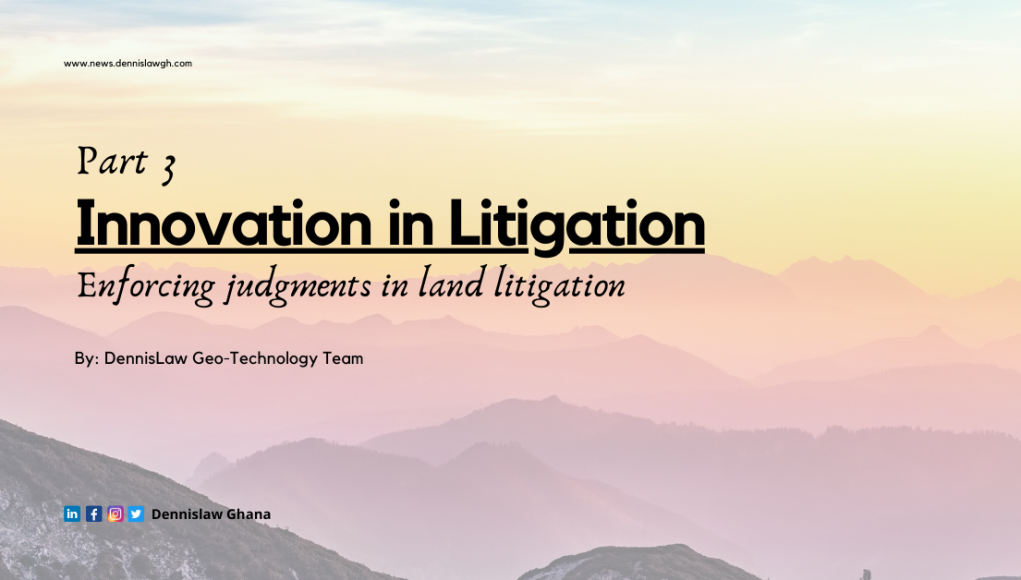Part 3: Innovation in litigation – Enforcing judgments in land litigation with technology
The viability of such technology not violating the rights of persons fromthe above case law shows it must always be approached from a public law perspective where they are conducted by public officials within public navigable airspace or from a public vantage point where the officials have a right to be.

In this concluding discussion on how to introduce modern technology in land litigation disputes, we explore how to enforce judgments in land matters with technology as well as notable challenges.
- Part 1: Innovation in litigation – Doing “Locus in quo” visitation virtually
- Part 2: Innovation in Litigation: Preparation of composite plans in land litigation
A. ENFORCEMENT OF JUDGMENTS IN LAND MATTERS
Notwithstanding the numerous mishap that occur during trials, when trials finally come to a end and the writ of possession is granted another misunderstanding often ensues. This often the a corollary problem associated with the use of wrong site plans during proceedings. It has been deemed that enforcement of judgment in land matters can be an uphill task for all parties. As pointed out by the learned author, Yaw Oppong in his book, “Contemporary trends in the law of Immovable Property in Ghana” he indicates that the enforcement of judgments in relation to immovable property is one of the most complex areas of legal practice. In practice, some parties have been in the mysterious habit of enforcing judgments beyond that claimed at the hearing. This has often led to the demolition of houses and properties of people who were not parties to the judgement in respect of which if the execution has been imposed. What happens in most cases is that the parties who have applied for the writ of possession are those who direct the bailiffs and the police as to the extent of the land in dispute A similar instance came for consideration before the Supreme Court in the case of Nene Narh Matti & Ors v Osei Godwin Teye; Samuel Yamm Oyortey and Ors v Osei Godwin Teye[1] where in the case, the Circuit court judge had granted one of the defendants with a writ of possession who went ahead of himself to trespass on the property of innocent parties without a valid court order. In the Supreme Court, their Lordship noted the evidence of the Defendant as follows:
“After the writ of possession was granted to us, we were accompanied by the Akropong-Police to demolish some of the structures on the land. It is not true that we have trespassed on the land of the Plaintiff measuring 16,325.27. We don’t share boundary with the plaintiffs on any portions of our family”
This problem of parties taking undue advantage of the land of others during execution is predominantly because of the poor nature of land markings and planning in Ghana.
This issue can easily be resolved if the court request for drone shots or videos or Digital Satellite Maps of the Judgment Plan. This plan would clearly show in picture form the current state of the land that title has been declared for the judgment creditor. The Digital images of the judgment in this regard would present less to no mistake in enforcement of judgements. For instance, if there is a judgment granting a parting to the title of the Law Court Complex in Accra. The Digital judgment plan will clearly show the nature and size of the land to be recovered and in case of demolition, the extent of the demolition can be marked. It will prevent chances of the Ghana Health Service Building being demolished in the process since it clearly show the boundaries of the recovered land. Additionally, judges can use drones to acquire timely update on lands before granting any writ of possession. The court can also verify whether all persons on the land to be recovered have been given notice of same as required by law instead of simply relying on proof of service of a compromised bailiff. As Ghana has already taken steps with the use of UAV drones in the health, same can be done in the legal sector.

CHALLENGES OF THE TECHNOLOGY
The establishment of these technologies may present some difficulties such as the cost in acquiring and maintaining these technologies and their gadgets in the various courts. This notwithstanding there are simple and free technologies such as Google Earth, Street View and others may be initiated as part of the technology reform agenda. The judge’s chance of having his eyes opened by way of Digital maps will prevent injustice being carried out at the blind side of the judge.
Furthermore there are concerns of the use of such aerial technology have been in relation to issues of privacy. Some private parties have considered the flying of drones over their properties a violation of their rights to property and even a trespass to their property in the law of torts. Nonetheless the case law in other jurisdiction favour the fact that the use of Drone and other form of technology in such proceedings must be monitored to prevent an abuse of the rights of the citizenry. In addition, the task must carried out by an official of the government in a non-intrusive manner as much as possible. The government must be able to retain any confidential information it may come across as confidential. In the case of Florida v Riley for instance it was held that the act of the government in taking the requisite information will not be a violation of the right to privacy of the people so long as the government the “government conduct does not reveal “intimate details connected with the use of the home or curtilage”. [2] The reasoning of the Court was to the effect that the police traveling in the public airways at an altitude of 400 feet need not obtain a warrant in order to observe what is visible to the naked eye. Further in the case of Dow Chemical Co v United States,[3] it was held that “the use of an aerial mapping camera [by the Environmental Protection Agency] to photograph an industrial manufacturing complex from navigable airspace similarly does not require a warrant under the Fourth Amendment”. Other cases such as California v. Ciraolo[4] and United States v. Causby,[5] have similar ratio.
The viability of such technology not violating the rights of persons fromthe above case law shows it must always be approached from a public law perspective where they are conducted by public officials within public navigable airspace or from a public vantage point where the officials have a right to be.
CONCLUSION:
Ghana in addition to the e-justice system should consider embracing GIS and UAV technologies in the judiciary to aide remedy some of the problems associated with land litigations..
The adaptation of GIS technologies such as digital mapping and cartography which has the ability to provide greater flexibility of content and image with increased accuracy and certainty, realism of photographic imagery and three-dimensional modeling layering, and satellite imagery as well as examine complex nature of demarcations will make it possible for judges to inspect the real and current state of the land or property in dispute. Primarily the use of GIS technologies will ultimately hasten trial processes as well as reduce the work burdens on judges giving them the ample time to attend to other cases
Generally the incorporation of these technologies into our judicial structure or court setting particularly in the area of land litigation will speed up land dispute trials and promote access to justice in the country. Its inclusion in our legal procedure will again help to fight corruption (by curbing fraudulent activities to a large extent). Additionally, the system will improve our land and housing systems and expedite land litigations. It will lighten the burden of proving one’s case in relation to landed property in court.
Technology has already invaded every facet of human life and as a country embarking on an E-Transform programme, a critical look at the GIS and UAV technologies and its impact on our judicial process will be of great benefit to the country. It will cure the blindness of the court in land litigation and block deception of the parties on the court. The eagle eye of the court in land litigation will ensure transparency and build trust in the justice delivery system.


